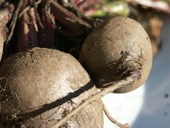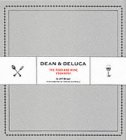
UK/Ireland
•Canada/USA
________________________________________________________________________

eat
beet
Many people are averse
to beet having only experienced crinkle-cut slices steeped in overpowering
vinegar. This is a shame because fresh beet has much to commend it in
terms of flavor (sweet, slightly earthy), texture (smooth and velvety)
and color (dark red/purple, or an appealingly lurid pink when combined
with cream or yoghurt).
These attributes make it a key ingredient in many fabulous salads such as Beet Koshumbir (see PICK OF THE RECIPES). And if you haven't tried fresh beet juice you may be pleasantly surprised at how subtle it is, particularly when offset with a sharper ingredient such as orange or apple.
HISTORY
Beet evolved from wild seabeet which is a native of coastlines from India to Britain. Two thousand years ago, prior to being modified by cultivation techniques, beet had a carrot-shaped root and only the leaves were eaten (the small root was used for medicinal purposes by ancient Greeks and Romans). The familiar rounded root variety was developed around the sixteenth century and gained widespread popularity in Europe a couple of hundred years later.
Today beet is common throughout much of North America and Europe. It is used extensively in Scandinavian, Eastern European and Russian cuisine.
BIOLOGY
The beet plant, Beta vulgaris, has deep tap roots and can grow in a variety of soil conditions. Other members of the genus include chard, sugar beet, spinach and samphire. The red variety is dominant but golden and white beet is grown on a smaller scale.
NUTRITION
Beet has a higher sugar content than most vegetables. It is rich in vitamin C, fiber, potassium, magnesium, manganese, and folic acid. The leafy tops are an excellent source of beta-carotene, iron and calcium.
TIPS
BUYING
Beet should be firm with a smooth, undamaged surface. Smaller roots are
more tender - avoid any larger than about 2½" diameter as
they may have tough, woody cores.
If you want to use the leaves they should be crisp, fresh looking and not too long or thick (if you don't, it doesn't matter too much if they're a bit limp as they deteriorate much more quickly than the root).
STORING
Cut off the leaves and store in an unsealed plastic bag in the fridge.
The leaves should be used within a day or two but the root will keep for
a couple of weeks.
PREPARING
Tender baby roots can be grated raw in salads. Mature beet can be boiled
(better for smaller, younger beet) or wrapped in foil and baked (better
for larger, older roots).
To preserve the beet's color and nutrients, rinse and brush clean but do not remove the skin or root until after cooking. Cook until a skewer easily penetrates to the core (anything from 40 minutes to 2½ hours boiling or 1½ to 3 hours baking at 350°F). You may want to wear rubber gloves when cutting and handling beet as the pigmentation leaves a pretty stubborn stain.
The leaves can be cooked like spinach - steam uncovered in a pan with a small amount of boiling water (around ½" depth).
OTHER STUFF
Extensive information on beetroot (what beet is known as in the UK), and some other interesting stuff, can be found on this website.
PICK OF THE RECIPES
in
season:
january
february
march
april
may
june
july
august
september
october
november
december
main regions:
Southern Canada, Northern USA
ONLINE
IN PRINT
-
Roasted Beet Salad with Mâche and Yellow Tomato-Tarragon Vinaigrette
Dean & Deluca: The Food and Wine Cookbook -
Roast Wild Duck with Port, Beetroot and Blackcurrant Sauce
Simply the Best: The Art of Seasonal Cookery -
Roast Carrot and Parsnip Salad with Soured Cream, Beetroot and Walnut Vinaigrette
The Complete Cookery Year


